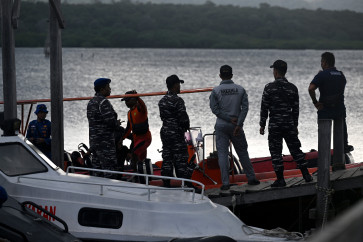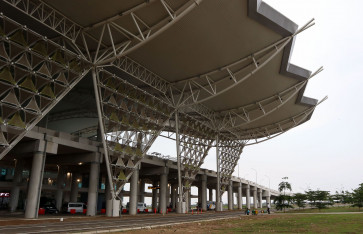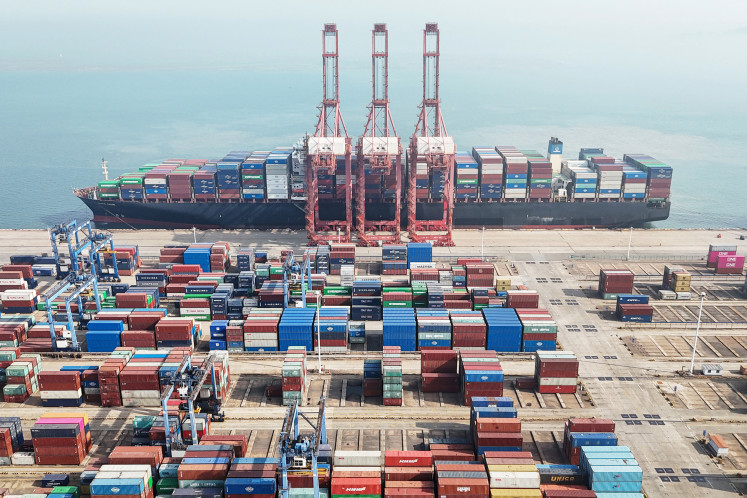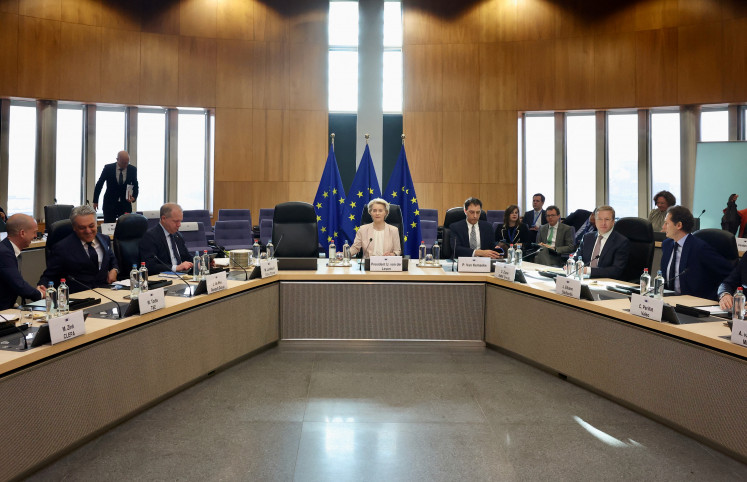Popular Reads
Top Results
Can't find what you're looking for?
View all search resultsPopular Reads
Top Results
Can't find what you're looking for?
View all search resultsQuest for insurance scheme for RI’s geothermal future
Geothermal energy has remained largely underdeveloped and underutilized in Indonesia, despite the many advantages it has to offer compared to currently widely used types of energy like oil, gas and coal
Change text size
Gift Premium Articles
to Anyone
G
eothermal energy has remained largely underdeveloped and underutilized in Indonesia, despite the many advantages it has to offer compared to currently widely used types of energy like oil, gas and coal.
Indonesia, however, needs to come up with fiscal incentives to turn these comparative advantages for geothermal into a significant contribution to the government’s plan to build by 2019 power plants to produce 35,000 megawatts of electricity.
Under the 2014 National Energy Policy, renewable energy must contribute up to 23 percent of Indonesia’s overall energy mix by 2025. Geothermal currently accounts for a small part of that mix, a mere 1,493.5 MW. The government plans to bring this up to 7,000 MW by 2025, which means building at a rate of 550 MW a year.
Geothermal power plants are environmentally sustainable. They leave no carbon footprint, and the only waste comes in the form of hot water and a tiny amount of hydrogen sulfide, which is injected back into the reservoir as substitute fluids.
Unlike oil, gas or coal, the environmental contamination from geothermal exploration and exploitation is negligible. Given the nature of geothermal — fluids and hot steam — it is a source of energy that can only be used for local power generation, not for exports.
The targeted 5,500 MW of additional geothermal capacity by 2025, if achieved, will represent a significant cut in carbon dioxide emissions, the equivalent emissions from 38 million tons of coal or 25 million tons of petroleum. It will replace 88 million barrels of petroleum or 13 million tons of coal that Indonesia burns each year. In monetary terms, this will be a saving of $4.5 billion currently spent on petroleum or $1.5 billion on coal every year.
Geothermal therefore plays an important role in reducing Indonesia’s dependence on fossil fuels.
Where then is the comparative disadvantage that has hampered the development of geothermal energy?
Well-drilling exploration and development represent the biggest risks in this business. No financial institutions in Indonesia offer funding for geothermal exploration.
In countries like Iceland, Germany and many in East Africa aided by the World Bank and France, geothermal companies enjoy the support of an exploration insurance scheme. Other countries offer incentives for clean energy development.
Indonesia should follow these examples.
Three state-owned enterprises — oil and gas company Pertamina, geothermal power producer PT Geo Dipa Energi and power company PLN — have been assigned to tap and build geothermal power facilities in the country.
In 2011, the Finance Ministry set up the Geothermal Fund Facility (GFF) to be managed by state-owned infrastructure financing company PT Sarana Multi Infrastruktur (SMI) to help accelerate geothermal energy development.
The House of Representatives followed suit by approving a line item of Rp 1 trillion annually for the GFF between 2011 and 2013. The fund, however, has remained largely unspent because of uncertainties and risks in the absence of insurance cover. An insurance scheme for geothermal exploration would not only mitigate the risks from drilling failures, but it could also cut project financing costs.
Many countries have developed geothermal facilities by mitigating the risks of exploration through financial and fiscal incentives provided by their governments. They include loan guarantees, partial collateral costs for drilling failures, an insurance program to support the costs of exploration, a tax deduction on the construction of geothermal facilities and a guarantee of energy sales at attractive prices.
The yearly Rp 1 trillion set aside for the GFF in 2011 to 2013 could be revived, but it would only be effective if we had an insurance scheme in place.
What is the risk, exactly?
Published data on drilling of 300 geothermal wells show a 75 percent success ratio, each with a production capacity of more than 7 MW. This compares with an average success ratio of 7 to 10 percent in hydrocarbon drilling in Indonesia.
But even wells with generating capacity of less than 5 MW are still economically viable and can be built in areas where the market is small.
Insurers need more data and information to gain a better understanding of exploration risks. They need to have access to geology feasibility studies, interpretations of seismic investigations, the concept of enterprise development, the design of the well location and well-stimulation programs. They need to have knowledge about the development of a geothermal power plant, the licenses involved and information about contractors and vendors, including their directors, and independent experts responsible for developing the proposal.
Unlike fossil fuels, developing renewable energy resources, including geothermal, could apply for concessionary loans from developed countries under the “Low Carbon, low CO2 emissions” scheme.
The next step would be to bring the Financial Services Authority (OJK) into the picture to help define terms and conditions along with technical actuarial calculations to set insurance premium rates.
As geothermal wells are all onshore, unlike oil and gas where exploration is now concentrated mostly offshore, an insurance scheme could cover the government’s GFF.
With more than 150 volcanoes, of which 127 are active, Indonesia has an abundance of geothermal reserves waiting to be tapped.
It is a source of energy that has many comparative advantages, in various respects, from environmental conservation to costs. The one small disadvantage, the absence of an insurance scheme, is something that can be overcome.
The time is ripe for Indonesia to unleash the true energy of the Pacific Ring of Fire.
_________________________________
The writer is a member of the board of experts at the Indonesian Renewable Energy Society. He was recently installed as president director of PT Geo Dipa Energi. The views expressed are his own.










